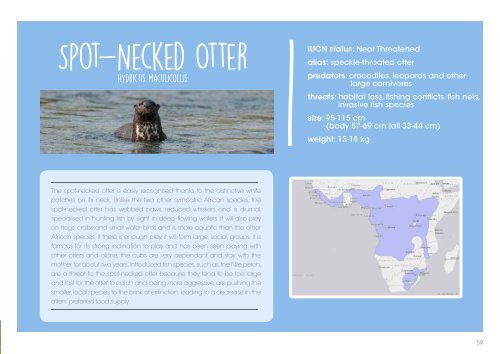OTTERS!
joopj4x
joopj4x
Create successful ePaper yourself
Turn your PDF publications into a flip-book with our unique Google optimized e-Paper software.
Spot-Necked Otter<br />
Hydrictis maculicollis<br />
IUCN status: Near Threatened<br />
alias: speckle-throated otter<br />
predators: crocodiles, leopards and other<br />
large carnivores<br />
threats: habitat loss, fishing conflicts, fish nets,<br />
invasive fish species<br />
size: 95-115 cm<br />
(body 57-69 cm tail 33-44 cm)<br />
weight: 13-18 kg<br />
The spot-necked otter is easily recognised thanks to the distinctive white<br />
patches on its neck. Unlike the two other sympatric African species, the<br />
spot-necked otter has webbed paws, reduced whiskers and is diurnal,<br />
specialised in hunting fish by sight in deep, flowing waters. It will also prey<br />
on frogs, crabs and small water birds and is more aquatic than the other<br />
African species. If there is enough prey, it will form large, social, groups. It is<br />
famous for its strong inclination to play and has been seen playing with<br />
other otters and alone; the cubs are very dependant and stay with the<br />
mother for about two years. Introduced fish species, such as the Nile perch,<br />
are a threat to the spot-necked otter because they tend to be too large<br />
and fast for the otter to catch and, being more aggressive, are pushing the<br />
smaller, local species to the brink of extinction, leading to a decrease in the<br />
otters’ preferred food supply.<br />
59


